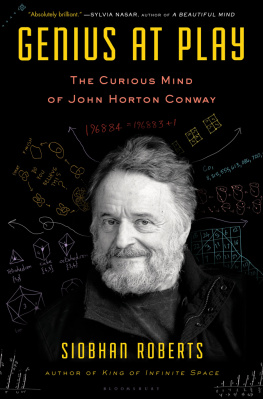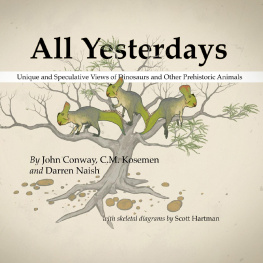BY THE SAME AUTHOR
Wind Wizard: Alan G. Davenport and the Art of Wind Engineering
King of Infinite Space: Donald Coxeter, the Man Who Saved Geometry

This electronic edition published in July 2015.
This electronic edition published in 2015 by Bloomsbury Publishing Plc
Bloomsbury USA
An imprint of Bloomsbury Publishing Plc
| 1385 Broadway | 50 Bedford Square |
| New York | London |
| NY 10018 | WC1B 3DP |
| USA | UK |
www.bloomsbury.com
BLOOMSBURY and the Diana logo are trademarks of
Bloomsbury Publishing Plc
First published 2015
Siobhan Roberts 2015
All rights reserved
You may not copy, distribute, transmit, reproduce or otherwise make available this publication (or any part of it) in any form, or by any means (including without limitation electronic, digital, optical, mechanical, photocopying, printing, recording or otherwise), without the prior written permission of the publisher. Any person who does any unauthorised act in relation to this publication may be liable to criminal prosecution and civil claims for damages.
No responsibility for loss caused to any individual or organization acting on or refraining from action as a result of the material in this publication can be accepted by Bloomsbury or the author.
ISBN: HB: 978-1-62040-593-2
ePub: 978-1-62040-594-9
LIBRARY OF CONGRESS CATALOGING- IN-PUBLICATION DATA HAS BEEN APPLIED FOR.
The author acknowledges for their financial support the Canada Council for the Arts and the Ontario Arts Council.

To find out more about our authors and books visit www.bloomsbury.com. Here you will find extracts, author interviews, details of forthcoming events and the option to sign up for our newsletters.
Bloomsbury books may be purchased for business or promotional use.
For information on bulk purchases please contact Macmillan Corporate and Premium Sales Department at
For
D.A.B.B.
D.A.B.R.
D.C.N.R.
Tell all the Truth but tell it slant.
EMILY DICKINSON

CONTENTS
PROLOGUE
Were he not such an egomaniac, John Horton Conway, archly roguish with a gawky, geeky magnetism, might be writing this book himself. Eyes smiling, hands clasped proudly at his chest, he easily admits,
I do have a big ego! *
As I often say, modesty is my only vice. If I werent so modest, Id be perfect.
* Conways ego is so sizable that it seemed to demand its own font. This is how you shall encounter him throughout the book.
Everyone who knows him knows it. Most everyone loves him nonetheless. Conways is a jocund and playful egomania, sweetened by self-deprecating charm. Based at Princeton University, though having made his name and found fame at Cambridge, he claims never to have worked a day in his life. He purports instead to have piddled away reams and reams of time playing games. Yet he is the John von Neumann Distinguished Professor in Applied and Computational Mathematics. Hes a Fellow of the Royal Society of London for Improving Natural Knowledge, a particularly august club, the oldest scientific society in the worldand Conway likes to mention that when he was elected in 1981, he signed the big book of fellows at the induction ceremony and was pleased to see on previous pages the names Isaac Newton, Albert Einstein, Alan Turing, and Bertrand Russell.
Not surprisingly then, considering the company hes keeping, Conway is roundly praised as a genius. The word genius gets misused an awful lot, says Stanford mathemagician Persi Diaconis. John Conway is a genius. And the thing about John is hell think about anything. Most mathematicians are analysts or group theorists or number theorists or logicians. John has contributed to every single one of those areas, and yet doesnt fit into any. He has a real sense of whimsy. You cant put him in a mathematical box. He factors large numbers in his head, he pulls out of a hat (reciting from memory to 1,111+ digits, that is), and hes been known to carry on his person a few decks of cards, dice, ropes, pennies, coat hangers, sometimes a Slinky, maybe a miniature bicycle, all props he deploys to extend his winning imagination.
He is among the most charismatic figures in mathematics, says Baron Martin Rees of Ludlow, a former colleague of Conways at Cambridge and former president of the Royal Society. Biologists speak of a species as charismatic for its ability to draw attention to itself. Theres a charismatic walrus that whistles, growls, and roars on cue into a microphone. Conway looks the part of a walrus, scruffily hirsute, and he seems to take his cue from Lewis Carrolls Walrus: The time has come, the Walrus said, To talk of many things.... Conway likes to talk, and talk and talk and talk. His voice is a rich, gravelly baritone, with a lingering Northern English lilt, that makes anything sound interesting, a voice you can listen to foreveralmost. He was by far the most charismatic lecturer in the faculty, says another Cambridge colleague, Sir Peter Swinnerton-Dyer. Im not sure that I can describe how charisma happens. It just is or isnt. And with most mathematicians it markedly isnt.
Still, for Conway, writing his autobiography would be unseemly. Partly because hes an insecure egotist. He very much cares what other people think, and he worries that a self-portrait might come off as too egotistical. And partly because hed have a hard time with the fiction of humility that the conventional autobiographer must at every moment struggle to maintain, as the occasional biographer Janet Malcolm describes the dilemma. So hell stick to doing what he does best. Gnawing on his left index finger with his chipped old British teeth, temporal veins bulging and brow pensively squinched beneath the day before yesterdays hair, Conway unapologetically whiles away his hours tinkering and thinkeringwhich is to say hes ruminating, or maybe he is doing some work, but hell insist hes doing nothing, being lazy, playing games. Witnessing Conways gamesomeness over the years, James Propp, a professor of mathematics at the University of Massachusetts Lowell, observed: Conway is the rare sort of mathematician whose ability to connect his pet mathematical interests makes one wonder if he isnt, at some level, shaping mathematical reality and not just exploring it. The example of this that I know best is a connection he discovered between sphere packing and games. These were two separate areas of study that Conway had arrived at by two different paths. So theres no reason for them to be linked. But somehow, through the force of his personality, and the intensity of his passion, he bent the mathematical universe to his will.
The hoity-toity Princeton bubble seems an incongruously grand home base for someone so gamesome. The campus buildings are Gothic and festooned with ivy. Its a milieu where the well-groomed preppy aesthetic never seems pass. By contrast, Conway is rumpled, with an otherworldly mien, somewhere between The Hobbits Bilbo Baggins and Gandalfa look that should earn him a spot in the online quiz featuring portraits of frumpy old men under the rubric Prof or Hobo? He wears faded and frayed chinos, stained with splotches that he camouflages by doodling spirals or crisscrosses over top with his pen. Above the waist he always wears a T-shirt emblazoned with a mathy message, such as:

















